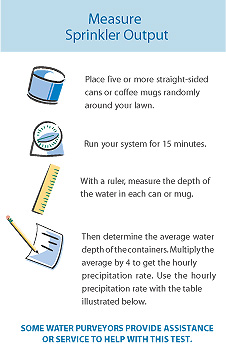- Basic Watering Information
- General Tips
- Watering Device Types
- Common Irrigation Challenges
- Sample Irrigation Schedules
Sample Irrigation Schedules
Many homeowners request irrigation schedules to help them program their controllers. Keep in mind that any schedule needs to be adjusted based on the type of irrigation equipment, soil type, slope, plant type and season. The first step creating a schedule for your turf is to measure the output of your sprinklers by performing this "Can Test":
Measure Sprinkler Output

-
Place five or more straight-sided cans or coffee mugs randomly around your lawn (cat food or tuna cans work well).
Run your system for 15 minutes.
With a ruler, measure the depth of the water in each can or mug.
Add up the depth from each container
Example: .5 + .25 + .75 + .25 + .5 = 2.25Then determine the average water depth of the containers.
Example: 2.25 / 5 = .45Multiply the average by 4 to get the hourly precipitation (sprinkler output) rate.
Example: .45 x 4 = 1.8 inches per hourUse the hourly precipitation rate with the table below. (Round sprinkler output down if necessary to a number closest on the chart.)
Determine How Long to Water Your Lawn
The charts below for Warm Season Turf and Cool Season Turf are to be used only as guides. During winter months, water only during extended dry periods. These charts assume that your irrigation system works efficiently and that you have resolved any common irrigation issues.

Soak and Cycle - To make sure your landscape can absorb all the water it needs, divide your total watering time into two or three cycles. For example, if your lawn requires 15 minutes of watering, don’t water once for 15 minutes. Instead water three times for five minutes each and try to water between midnight and 6:00 a.m. Remember, the ground is like a sponge, so allow enough time in between each cycle (about one hour) for the water to soak into the soil. This is especially important for sloped areas or clay soil.
Irrigation Frequency - Although the preferred watering frequency is not more than three times per week, you may need to water more frequently if the soil beneath your lawn is compacted, if the lawn has a thick layer of thatch, or if it is on a slope. You may want to aerate or dethatch, so water can percolate into the soil. If that is not possible, you may need to water more frequently during the hot summer months.